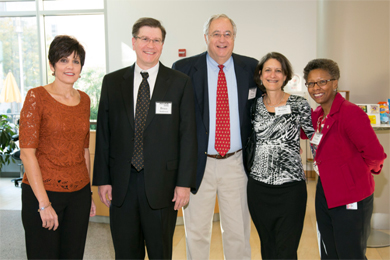Maryland Poison Center Celebrates 40 Years of Lifesaving Service
School of Pharmacy's Bruce Anderson recalls MPC's critical role from everyday household toxic exposures to nationwide crises.
By: Steve Berberich
Friday, November 9, 2012

At the University of Maryland School of Pharmacy, the Maryland Poison Center (MPC) is marking its 40-year anniversary by releasing some eye-popping statistics on its operation through the years, such as responding to 2,024,639 calls on its dedicated phone lines.
More than 1.2 million of the calls concerned people who were exposed to toxins, said Bruce Anderson, PharmD, DABAT, director of operations for the MPC and an associate professor of pharmacy practice and science, in delivering the School's annual Francis S. Balassone Memorial Lecture.
At the Poison Center, certified toxicology specialists routinely respond to calls for help from professionals, such as first responders, emergency room personnel, hazardous materials experts, and others, Anderson said.
"Also, we have received more than 870,000 calls from people's homes. If they did not call us, they would call 911, a doctor, or go to the hospital. Poisoning cases managed in the emergency room average a cost savings of between $500 to $1,000 each. That means we've saved people a combined total of between $439 million and $878 million," Anderson said.
In his Oct. 31 lecture, "Celebrating 40 Years of Change in Poison Center Practice," Anderson recalled how the center was a key information source during various infamous toxic incidences, including a nationwide recall of Tylenol products in 1982 after seven people died when someone laced some of the medicine capsules with potassium cyanide, the 2001 when a bioterrorist mailed letters of deadly anthrax powder, and in the 1970s when widespread poisonings resulted from people siphoning gasoline during gas rationing.
"Besides the success the Maryland Poison Center has had, what is really remarkable is that the individuals involved in the Maryland Poison Center helped define what a poison center should be," said Anderson. 'We added health education and outreach to the mission of the Poison Center. There were no guidelines for that back in 1972. No professional organization was saying 'Thou shall or shall not.' We just did it because it was the right thing to do."
At the beginning, in 1972, the Maryland Poison Center received 5,600 calls a year. Anderson said in 2011, that number had swelled to more than 62,000. "Today, there are poison specialists sitting in front of a series of computer screens. All cases are documented in near real time. And we submit our data, as do all 57 poison centers in the country, to a national data collection system that looks for trends and public health outbreaks."
The MPC trains pharmacists, paramedics, physicians, and other health care workers to know and respond to toxic situations. "We have helped define what it means to be a certified poison center and several of our past fellows are in leadership positions now at poison centers around the country," Anderson said. "On the horizon, we are looking to provide the information we gather to state and local health departments in near real time. We are setting parameters for dates, locations, substance exposures, and more.
Anderson pointed out that he was delivering his lecture on the heels of a new report on the value of such poison center services. The Lewin Group, an independent research firm, reported that poison centers save more than $1.8 billion per year in medical costs and lost productivity, or a savings of $13.39 for every $1 spent on poison center services. The "Final Report on the Value of the Poison Center System," Lewin Group, Inc., September 2012, determined that poison centers save $752.9 million per year due to avoided medical utilization by keeping the majority of patients at home instead of unnecessarily using emergency medical services and hospitals, $441.1 million per year due to a reduction in hospital length of stay of an average of 3.2 days when a poison center is consulted, $23.9 million per year due to educational outreach that helps to prevent poisonings and improve medical response, and $603 million per year due to reduced work-loss days due to unnecessary medical encounters.
Anderson said that rumored state and federal budget cuts could make it difficult for poison centers to continue to provide the same lifesaving services.
The Maryland Pharmacists Association and the School's Alumni Association established the annual Balassone lecture in 1976 in memory of Francis Balassone, an alumnus of the Class of 1940, and a faculty member at the School. Balassone was executive secretary of the Maryland Board of Pharmacy and was instrumental in establishing the first School-based pharmacy student externship program in the nation.
Anderson previewed his Balassone lecture presentation on Oct. 21, as the School of Pharmacy hosted a celebratory brunch in honor of the Poison Center's 40th anniversary. The brunch was attended by faculty and staff from the School, as well as former Poison Center employees, students, and professional colleagues and collaborators, including Joshua Sharfstein, MD, secretary of the Maryland Department of Health and Mental Hygiene, and David Fowler, MD, the state's chief medical examiner.